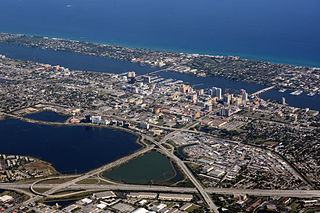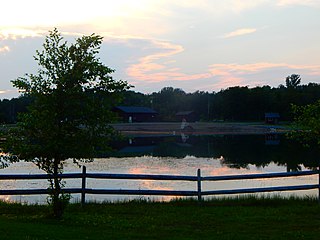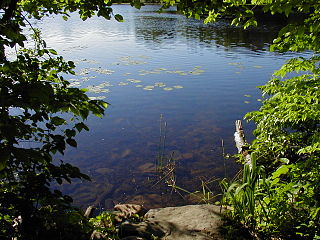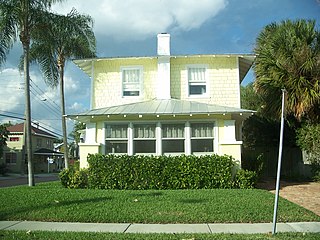
Palm Beach County is a county in the southeastern part of Florida, located in the Miami metropolitan area. It is Florida's third-most populous county after Miami-Dade County and Broward County and the 26th-most populous in the United States, with 1,492,191 residents as of the 2020 census. Its county seat and largest city is West Palm Beach, which had a population of 117,415 as of 2020. Named after one of its oldest settlements, Palm Beach, the county was established in 1909, after being split from Miami-Dade County. The county's modern-day boundaries were established in 1963.

Lake Clarke Shores is a town in Palm Beach County, Florida, United States. The town is part of the Miami metropolitan area of South Florida. The 2020 census recorded a population of 3,564.

Lake Worth Beach, previously named Lake Worth, is a city in east-central Palm Beach County, Florida, United States, located about 63 miles (101 km) north of Miami. The city's name is derived from the body of water along its eastern border known as the Lake Worth Lagoon, which was named for General William J. Worth, who led United States Army forces during the last part of the Second Seminole War. Lake Worth Beach is situated south of West Palm Beach, southeast of Lake Clarke Shores, east of Palm Springs, and north of Lantana, while a small section of the city also partitions the town of Palm Beach. The 2010 census recorded a population of 34,910, which increased to 42,219 in the 2020 census. Lake Worth Beach is within the Miami metropolitan area, which was home to an estimated 6,138,333 people in 2020.

Palm Springs is a village in Palm Beach County, Florida, United States, situated approximately 61 mi (98 km) north of Miami. The village's name was likely derived from the resort city of Palm Springs, California. Located in the east-central part of the county, Palm Springs is situated north of Atlantis, east of Greenacres, west of Lake Clarke Shores and Lake Worth Beach, and southwest of West Palm Beach. The 2010 United States census recorded the village's population at 18,928, which increased to 26,890 in the 2020 census. Palm Springs is also located within the Miami metropolitan area of South Florida, which had a population of approximately 6,138,333 people as of 2020.

Royal Palm Beach is a village in southeast Florida, located within Palm Beach County. Despite its name, the village is located approximately fifteen miles inland from the Atlantic Ocean. It is part of the Miami metropolitan area. The population was at 38,932 residents in the 2020 US census.

Darien Lakes State Park is a 1,845-acre (7.47 km2) state park in western Genesee County, New York, near Darien Center. The park entrance is on Harlow Road, north of U.S. Route 20.

The Oleta River State Park is a 1,033-acre (418 ha) state park on Biscayne Bay in the municipal suburb of North Miami Beach in metropolitan Miami, Florida. Adjoining the Biscayne Bay Campus of Florida International University, the park contains one of the largest concentrations of Casuarina trees, an invasive species in the state park system. Along the park's coastline are mangrove forests. They provide vital nurseries for aquatic life and filter urban pollutants from coastal waters. The state park promotes biodiversity of flora and fauna through the assistance of Friends of Oleta River State Park. The 501(c)(3) nonprofit citizen support organization (CSO); sponsors events, raises funds, and advances the goals of Oleta River State Park. The state park hosts about 15 endangered species.

Brown County State Park is located in the United States in the center of the southern half of the state of Indiana. The park is by far the largest of 24 state parks in Indiana, and occupies 15,776 acres (63.84 km2)—making it one of the larger state parks in the United States. It is among Indiana's most visited state parks with about 1.2 million visitors annually. Although Bloomington, Indiana, is the closest city, the park is closer to the small town of Nashville in Brown County. Brown County is named for General Jacob Brown, who fought in the War of 1812 and became Commanding General of the United States Army.
Stony Creek Metropark is a Huron-Clinton Metropark located in southeast Michigan in the outskirts of metro Detroit. The park is predominantly in Washington Township and Oakland Township, with a small portion in Shelby Township. The park covers 4,461 acres (18.05 km2) with Stony Creek Lake at its center.
Taconic State Park is located in Columbia and Dutchess County, New York abutting Massachusetts and Connecticut within the Taconic Mountains. The state park is located off New York State Route 344 south of Interstate 90 and 110 miles (180 km) north of New York City. It features camping, hiking, bicycling, hunting, cross county skiing and other recreational opportunities.

Three Rivers Park District is a special park district serving the suburban areas of the Twin Cities including suburban Hennepin, Carver, Dakota, Scott, and Ramsey counties. Three Rivers's mission is "To promote environmental stewardship through recreation and education in a natural resources-based park system." Three Rivers operates twenty parks and ten regional trails, with at least two more regional trails planned. Nearly seven million people visit Three Rivers facilities each year. It has over 27,000 acres (11,000 ha) of parks and trails.

Lebanon Hills Regional Park is a park in Eagan and Apple Valley, Minnesota. The 1,869-acre (7.56 km2) park, the largest in Dakota County, contains forests, grasslands, marshes, and wetlands. Winter activities include skiing, snowshoeing, ice skating, ice fishing, hiking, and winter mountain biking. Summer activities include mountain biking, canoeing, kayaking, swimming, camping, horseback riding, and hiking.

The Mango Promenade Historic District is a U.S. historic district located in West Palm Beach, Florida. The district is bounded by South Dixie Highway, Austin Lane, Coconut Lane, and Cranesnest Way. It contains 125 historic buildings.

The Columbus and Franklin County Metro Parks are a group of 20 metropolitan parks in and around Columbus, Ohio. They are officially organized into the Columbus and Franklin County Metropolitan Park District. The Metro Parks system was organized in 1945 under Ohio Revised Code Section 1545 as a separate political division of the state of Ohio. The Metro Parks are overseen by a Board of Park Commissioners consisting of three citizens appointed to three-year terms without compensation by the Judge of the Probate Court of Franklin County, Ohio. The Board in turn appoints an Executive Director responsible for operations and management of the parks.

Crandon Park is an 808-acre (3.27 km2) urban park in metropolitan Miami, occupying the northern part of Key Biscayne. It is connected to mainland Miami via the Rickenbacker Causeway.

Whitefish Dunes State Park is a 867-acre (351 ha) state park of Wisconsin on the eastern shore of the Door Peninsula. This day-use park preserves the most substantial sand dunes on the western shore of Lake Michigan. The remains of eight successive prehistoric Native American villages are on the National Register of Historic Places as Whitefish Dunes-Bay View Site. Cave Point County Park is an enclave inside the state park, allowing visitors free foot access to the state park by the shoreline trail connecting the parks.

Oregon Ridge Park is a 1,043-acre (4.22 km2) park in Cockeysville, Maryland. The park features walking and hiking trails, nature center, picnic and recreation areas, a lodge, and cross-country skiing and sledding.
Seaside Park is an event venue in Ventura, California, United States. The 62-acre site (25 ha) is the home of the Ventura County Fair. Trade shows, concerts, and other events are held throughout the year at the fairgrounds. The beachfront site, near the mouth of the Ventura River, also includes Surfers' Point, known for its point break that produces distinctive waves.
Riverbend Park is a 680-acre (280 ha) park in the Jupiter Farms section of Jupiter, in Palm Beach County, Florida. The area includes the Riverbend Regional Park Historic District with Indian middens and a preserved battlefield from the Seminole War at the Loxahatchee River Battlefield Park adjacent to Riverbend. The park includes 10 miles of hiking/biking trails, 7 miles of equestrian trails and 5 miles of canoeing/kayaking trails and includes a section of the Loxahatchee River, a National Wild and Scenic River. A Florida cracker farmstead is displayed, as well as a Seminole-style chickee for picnics. The battlefield area was listed on the National Register of Historic Places in 2024.
Golfview was a town in Palm Beach County, Florida, in the United States. Golfview was chartered on June 11, 1937. The town, located near the southeast intersection of Belvedere Road and Military Trail and in very close proximity to the Palm Beach International Airport, remained small in both population and area. The highest recorded population of Golfview was 210 people, according to the 1980 census. By the mid-1980s, expansion of the airport and the surrounding area caused many residents to begin selling their homes. The town of Golfview officially dissolved on September 1, 1998.















